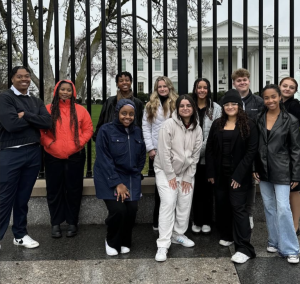Degenerate: adj. (1) inferior. (2) “having lost the physical, mental, or moral qualities considered normal and desirable; showing evidence of decline” (Encyclopedia.com). This word’s definition has shifted drastically after the events of World War II and is often associated with the racist concept of eugenics.
On Tuesday, September 17th, between the hours of six and eight o’clock in the evening, a discussion panel made up of three prestigious, conversant men discussed the drastic way in which one man’s idea of that word radically changed art and art history – irreparably. That one man was Adolf Hitler.
During World War II’s six-year-long global captivity, despondency, and sheer wreckage, Hitler managed to destroy hundreds of millions of lives through the pillaging of homes and the casualties of tens of millions.
For the most part, anything considered “degenerate” by the Nazis was non-classical: nouveau, different, artistically unique. Hitler, having been an ex-artist himself (rejected by the top art school in Vienna, shifting his focus then to politics), took it upon himself to rid the world of such abominations as the works of Vincent van Gogh, Gustav Klimt, Edgar Degas, and countless more. Europe was stunned and devastated–resorting to extremes in order to hide and protect the artwork remaining, yet to be looted.
I think it’s a beautiful thing when a treasure like an artistic family heirloom can be returned decades later to its rightful owner.
The three men who sat side-by-side in a Cornell Fine Arts Museum (CFAM) gallery room, faced a fully packed audience, are specialists in this semi-modern field of provenance study. This study is the research on art pieces’ ownership history. What they all seemed to agree upon was a lack of substantial funding to the specific field. But what I, as a member of the audience, found most enrapturing about the conversation and topic at hand was this idea of ownership, or more so, “entitlement.”
You see, when World War II ended, those famously devoted-to-the-arts Europeans (as well as many scholarly Americans) set out on a mission to retrieve the stolen art, whether it had been looted from a private collection or a museum/gallery. Some were returned, some had been destroyed, and some continue to surface all over the world to this day. I think it’s a beautiful thing when a treasure like an artistic family heirloom can be returned decades later to its rightful owner. However, I think it’s a tragic, despicably human-natured thing when great-great-nieces and -nephews and fifth-generation cousins get into legal disputes over who that “rightful owner” is.
It’s at that point when I am forced to side with many museum directors’ opinions: this renowned art serves a better purpose within the public sphere–not locked away in a private collection once more. While ownership and inheritance form a difficult path to talk any distant family member astray from, we had ought to be realists and take into account the elapse of time. World War II ended well over half of a century ago; who is to say any one of these paintings would have definitely remained with its original family? It could have been sold, traded, lost, or damaged at any point during the last nearly seven decades, instead of hanging where it does in an exhibition for anyone to enjoy.
But there are definitely cases where ownership has been made rather irrefutably obvious.
At Tuesday’s discussion, I was pleased to learn that the United States has a reputation for being the most compliant in returning looted artworks that have ended up on our museum walls to their rightful owners. However, some of those European countries, like I said, just really love fine art. You’d be hard pressed to find a simple, civil disagreement over the asserted claims overseas.
Cornell Fine Arts Museum, or CFAM is constantly hosting these types of cultured, relevant, and demonstratively provocative speaking events or discussion panels. Keep your ears perked and shuffle those schedules so next time you might join me in the audience.







Be First to Comment